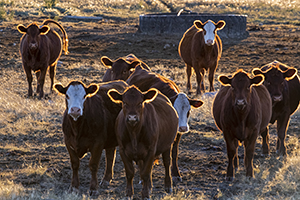Tips for Starting Lightweight Calves on Feed
CLICK THE PLAY BUTTON TO LISTEN TO THIS POST:
Listen to more episodes on BeefResearch.ca, Spotify, Apple Podcasts, Amazon Music or Podbean.

Many cow-calf producers from B.C. through Ontario are planning to wean and sell their calves earlier this year. Others are reluctant to sell lightweight calves into a flooded market so are thinking about retaining ownership, putting extra pounds onto lightweight calves, and selling into a more promising feeder market in early 2022.
Many factors need to be considered when preparing to feed lightweight calves.
Calves face health and nutritional hurdles as they are weaned and transitioned to a backgrounding diet. Because of Mother Nature’s cruel summer, those hurdles may be even higher for this year’s lightweight calves.
Despite producers’ diligence, calves from drought-stricken pastures will face unique challenges getting started on feed. The following tips and considerations can help calves be more resilient in the face of these added challenges.
Haven’t worked with nutritionists?
When you’re using unusual feed ingredients to reduce feeding costs, the added expense of working with a nutritionist is some of the cheapest insurance you can buy.
Sometimes it’s hard to know what nutrients, toxins or antinutritional factors to test for, or where to get things tested. A nutritionist can ensure samples are collected and submitted properly and to the right lab.
When the feed test reports come back, a nutritionist can make sense of them, and figure out the best way to combine your various feed options in a way that uses them as cost-effectively as possible.
Dry pastures shortchange calves
Forage from drought-stricken pastures will not have the same quality as forage in a normal year.
Moisture-stressed or overly mature forages are often deficient in energy and protein, as well as vitamins A, E and possibly D. Selenium and copper deficiencies may also be concerns in some areas.
If water sources are low due to evaporation, the salts and minerals will be concentrated in animals’ drinking water, too. Water quality can increase the risk of some mineral toxicities, and higher salt levels in the water may also reduce the consumption of free choice minerals, resulting in a mineral deficiency.
Young, growing calves have higher nutrient requirements, so nutrient toxicities or deficiencies can impact them more than mature cows. Nutrient challenges associated with forage and water will be carried into the corral after weaning.
Talking to a nutritionist is particularly valuable this year – they can interpret your feed and water lab test reports, help you understand the current nutritional status of your calves, determine what they’ll need to consume in the months ahead, and help develop strategies to economically cover the gaps.
Your veterinarian can also collect blood samples from a subset of your calves to check for acute mineral and vitamin deficiencies.
Weaning may be harder on young, lightweight calves
Weaning is stressful in normal years and may be even more of a challenge when calves are weaned early. Consider using low-stress weaning methods to help calves transition to dry feed more quickly and reduce the risk of illness. If feasible, keep cows and calves together for the calves’ first few days in a new pen. Cows will help calves find water, adjust to the new ration and become comfortable in their new environment.
Make every bite count
Transitioning weaned calves to a new feeding program is key to managing and or even reversing nutrient deficiencies they may have developed on pasture before weaning.
Calves might be reluctant to eat an unfamiliar ration for the first few days, but top-dressing the feed with a palatable supplement containing high levels of vitamins, mineral, protein, and energy can help.
If they’re not consuming much feed, increase the proportion of supplement that is top-dressed to make sure they benefit from the concentrated nutrition the supplement provides. As overall intake increases, decrease the amount of supplement provided.

Work with a qualified nutritionist to have your feeds tested and rations balanced
Just like pasture, growing conditions and stage of maturity of the feeds harvested for feedlot use will be different in a drought year than in a normal year. The nutrient content of each feed needs to be assessed separately to balance rations that will work at different stages of animal growth and different weather conditions. Last year’s feed test won’t apply to this year’s feeds, and book values won’t apply to alternate feeds.
The lack of hay might mean that your rations will contain a blend of feeds that are unfamiliar to you or your calves (e.g., a variety of salvaged crops, crop residues, weeds and by-products like screenings, canola meal, DDGS, straw, and other alternative feeds). Using a variety of feeds may be the only economical option but it will certainly make feed testing and ration formulation more complicated. These feeds will all have different energy, protein, vitamin, mineral, and antinutritional factors than traditional hay, silage or feed grains.
Feed tests based on near infrared spectroscopy (NIRS) are fast, cheap and accurate for protein and energy, but NIRS is not accurate for measuring mineral content. Traditional wet chemistry is important for minerals. This is more costly than NIRS but the information it provides is valuable.
For example, the high levels of sulfur in canola or water may bind up copper or selenium from elsewhere in the diet. Newly weaned calves may already be deficient in copper if your cattle come from a copper deficient (or sulfur abundant) area of the country. Having an accurate estimate of how much sulfur is present will determine whether (or how much) copper needs to be supplemented, and the most cost-effective way to supplement it (e.g., copper oxide or chelated copper). A selenium injection at weaning can temporarily correct deficiencies until the dietary mineral supplement has had time to restore adequate levels. Drought-stressed cereal greenfeed particularly that grown on manured soil may contain high levels of potassium that needs to be considered and potentially counter-balanced. Working closely with your veterinarian and nutritionist can help identify and correct problems early, before they become larger and more costly to fix. Potential problems in your calves may also highlight deficiencies (or toxicities) in the cow herd or bull battery that you may not otherwise recognize.
Feed tests are critically important, but they won’t tell you everything
Your nutritionist may be aware of some potential nutritional or animal health concerns that aren’t easily tested for and suggest ways to avoid them. For example, taking a big picture look at both the water and feed your calves are consuming can help prevent cumulative toxicity from sulphates or nitrates. Compounds such as oxalates from kochia and dicoumarol from sweet clover are difficult to test for. Nitrates, ergot and mycotoxins can be tested for, but careful feed formulation and management is critical to cope with them safely.
Remember that your nutritionist and veterinarian are your support team. They will each have unique expertise, insights and complementary skills to help cope with the challenges your calves are facing this year.
Cattle feed is rarely tested for B vitamins due to synthesis from rumen microbes, but B vitamin deficiencies can still be caused by high dietary sulfur levels, or by ruminal acidosis (grain overload). Both of those factors need to be considered. Some water sources may have high sulfur levels this year, which can lead to polio.
High barley prices may make wheat a more attractive feed grain, but it carries a higher risk of acidosis if not managed properly.
Successfully starting calves on feed is hard, even in a good year
Starting newly weaned calves on feed is challenging in good years, even for professionals. It will likely be even more challenging this year. The additional stress of early weaning, nutritional challenges and air quality can significantly increase the risk of respiratory disease in these calves.
Good nutrition is essential to ensure that animals respond to vaccinations fully. If calves were nutritionally stressed on pasture their immune status may be compromised, and vaccines may not provide full protection. Proactively work with your veterinarian to develop a solid preventative health program, as well as an emergency response plan in the event of an unexpected and significant outbreak of disease. Preweaning vaccination programs are an excellent way to maximize the calf’s ability to respond to vaccines. If you are retaining ownership, you will also retain the benefit of this optimal vaccine program.
Heat stress reduces feed intake, which slows gains and can compromise immunity. Misting sprinklers may help reduce heat stress, along with access to shade or a wind fence. Sprinklers should not be used in pens during mid-day as they can increase relative humidity and accidentally increase the heat load on cattle. Access to abundant fresh, clean water is critical to maintain health and welfare, encourage intake, and avoid heat stress. Consider setting up additional water troughs to ensure all animals can always access adequate water.
There have been a lot of air quality index warnings this summer due to wildfire smoke. Smoke and dust aren’t good for the human respiratory tract, and they likely don’t benefit cattle either. It is hard to know to what degree smoke and dust may increase the risk of respiratory disease in this year’s calf crop, but it’s doubtful that it’ll make the transition into the feedlot any easier.
There’s not much we can do about smoke, but we can try to minimize dust. Freshly weaned calves (especially abruptly-weaned calves) pace a lot. This creates even more dust in dry conditions. Removing loose dirt in pens is critical for dust control. Spreading straw or wood shavings and setting up a sprinkler can also help.
Between smoke and nutritional challenges, if you’re considering retaining ownership of calves this fall, this is a very opportune time to work with your veterinarian to develop or update your health prevention program.
When considering the expense of working with nutritionists and veterinarians, remember that an ounce of prevention is worth a pound of cure. Investing in good veterinary and nutritional services help to mitigate losses or turn a profit.
LEARN MORE
- Drought-Related Resources for Cattle Producers (BCRC post)
Acknowledgments
Thanks to the following individuals for contributing time and expertise to the writing of this article:
- Joyce van Donkersgoed, DVM
- Calvin Booker, DVM
- Craig Dorin, DVM
- Darryl Gibb, PhD
- John McKinnon, PhD
- Karin Schmid, MSc
- Jack Fisher, MSc
- Barry Yaremcio, MSc
Sharing or reprinting BCRC posts is welcome and encouraged. Please credit the Beef Cattle Research Council, provide the website address, www.BeefResearch.ca, and let us know you have chosen to share the article by emailing us at [email protected].
Your questions, comments and suggestions are welcome. Contact us directly or spark a public discussion by posting your thoughts below.